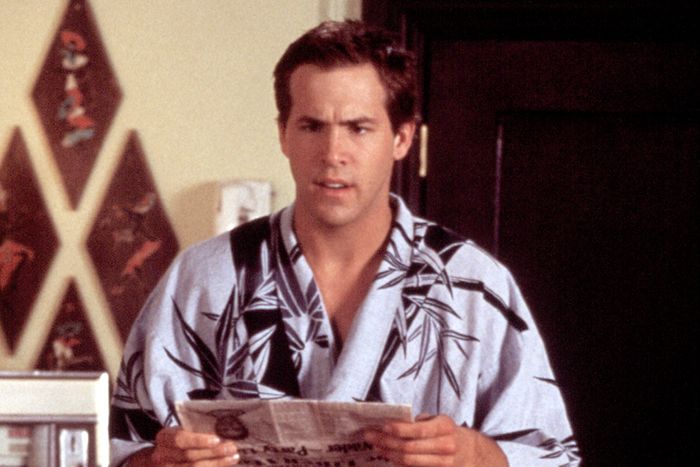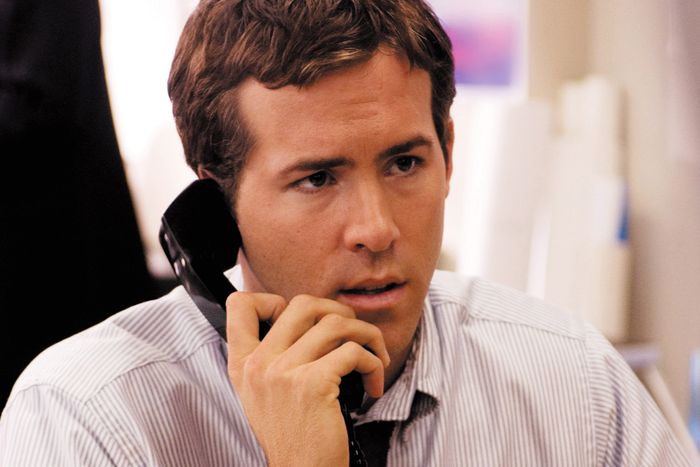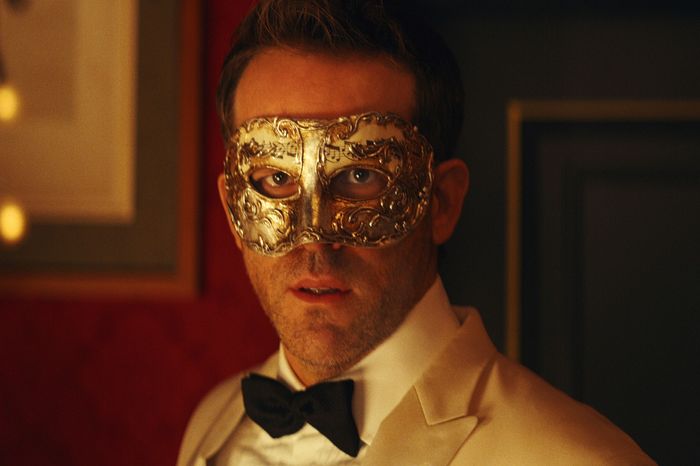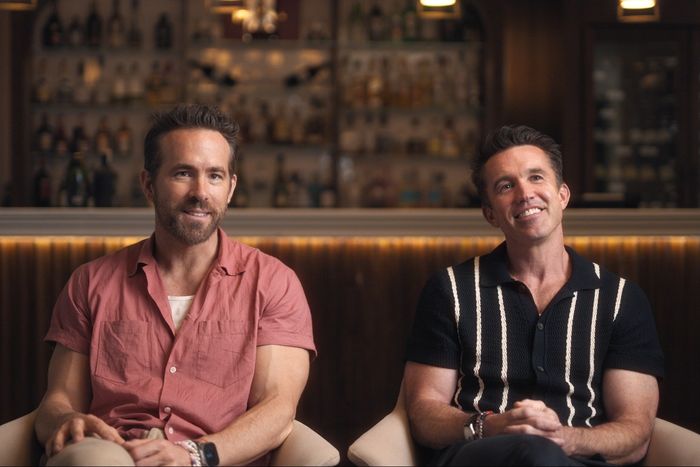Deadpool chose Ryan Reynolds. In 2004’s second issue of the comic Cable & Deadpool, written by Fabian Nicieza, the heavily scarred X-Men-adjacent mercenary describes himself as “Ryan Renolds crossed with a Shar-Pei.” Nicieza, who’s credited with coming up with the character’s voice in the ’90s, misspelled Reynolds’s name on purpose (Marvel was always litigiously cautious), but he meant the Canadian actor, whose fast-talking, self-deprecating sense of humor impressed him on the 1998 sitcom Two Guys, a Girl and a Pizza Place and in the 2002 National Lampoon movie Van Wilder. At the time, Nicieza thought Reynolds was too young to play Deadpool in a movie, but maybe it would work out in ten years.
Almost 20 years (11 in development), one test-footage leak, three movies (four if you count X-Men Origins: Wolverine, which you shouldn’t), $2 billion (and counting), and a corporate merger later, there is no comic-book character more connected with the actor who plays them than Deadpool and Ryan Reynolds. The former is a morally ambiguous vigilante who jokes to deflect intimacy and avoid silence. The latter is an underutilized Hollywood actor who jokes to deflect intimacy and avoid silence. Whereas these features of Reynolds’s personality come off as insincere and entitled when they’re attached to his face and body, when he’s Deadpool it all feels like play. What was once annoying is suddenly masked and appealing.
Not all superheroes wear masks. The Marvel Cinematic Universe is known for having its heroes flip open their masks during fight scenes so you never forget there is a movie star movie-starring. Not only does Deadpool stay masked more often than his peers, but under the mask there is another mask: layers of grotesque, wrinkly-skin makeup. Unable to form facial expressions with it on, Reynolds says his Deadpool performance is more physical, more clownlike. Technically, Deadpool is a bouffon, a classically French figure who connects to their audience not through radical vulnerability, like a clown, but by mocking the audience members and the work they have come to see. And Deadpool fans have come to see Reynolds, an actor Hollywood failed, over and over again after Van Wilder, to turn into a leading man. Deadpool isn’t just a character Reynolds was fated to play; it’s the rare franchise opportunity that lets the actor-producer — the first in MCU history — in on the joke of his own stunted movie stardom.


Superheroes have origin stories, and here’s Reynolds’s. As he tells it, he went to college for 45 minutes before moving to Los Angeles to join the comedy troupe the Groundlings. He was coming off three years on a teen drama in Vancouver, but he felt sketch and improv were his calling, his sense of humor stemming from a childhood spent currying favor with and defusing the tension of his tough, inaccessible “stress factory” father. But Reynolds quickly determined he didn’t have the money (or permanent citizenship) he would need to work his way up through the theater’s ranks, so he focused on getting cast on a TV show. Two Guys, a Girl and a Pizza Place ran for four seasons, and though critics widely dismissed the sitcom, many praised Reynolds. The New York Times’ Caryn James wrote that Reynolds’s “comic energy is better than his material,” while the Washington Post’s Tom Shales compared his performance, especially his vocal elasticity, to a young Jim Carrey.
Reynolds thrived in front of a live studio audience, playing a college-age rascal who was more interested in messing with his friends and pursuing harebrained schemes than deciding on a major. When Two Guys and a Girl ended, Reynolds found himself cast playing a role similar in 2002’s Van Wilder. The National Lampoon movie about a wisecracking college student who has been 18 credits shy of graduation for six semesters grossed $38 million on a $5 million budget with critics calling Reynolds as “charming as he is irrepressible.” Reynolds will often note that he was just aping Chevy Chase (“If I saw a supercut of my tricks from that period — the wry eyebrow raise, followed by the slow, deadpan turn … Ugh! Mortifying”), but he brought a sweet nervousness to the franchise that contrasted with Chase’s devil-may-care attitude. Van Wilder’s party-animal behavior is partly a performance born out of the fear of what hard life looks like when you lose your security.
In Van Wilder, Hollywood saw an actor who could slide into its plentiful tall-white-guy roles with his ability to sell so-so jokes and a face that is the perfect mix of symmetrical and nondescript. It was enough to get him cast in 2004’s Blade: Trinity, playing Blade’s ripped savior turned sidekick who is also the film’s comedic relief. It was reportedly a complicated shoot with Wesley Snipes going Method, rarely acknowledging his co-stars, and sometimes failing to show up to set at all. According to Patton Oswalt, the cast would ad-lib jokes for Reynolds to say to Blade in Snipes’s absence. The result is tone-breaking one-liners like “Darkcore, trip-hop, whatever kids are listening to these days. Me, I’m more of a David Hasselhoff fan, you know?” An executive from another studio saw early footage of Blade: Trinity and reached out to Reynolds to say that if they ever make a Deadpool movie, Reynolds should play Wade Wilson. The first issue Reynolds read was Cable & Deadpool No. 2.
A decade of hot-guy parts in action movies and romantic comedies followed. Some of these films would make a lot of money, like 2009’s The Proposal, in which Reynolds played Sandra Bullock’s assistant turned pretend lover turned [spoiler alert] real lover. It was a surprise smash, grossing $317 million worldwide, but the Times’ Manohla Dargis described Reynolds as “more decorative than anything else.” Many of his movies got bad reviews. There was what one critic called “his forgettable zeal” in 2005’s poorly received The Amityville Horror remake and his first turn as a major-superhero lead in 2011’s Green Lantern, which caused another critic to say Reynolds “looks like a slice of inert beefcake.” Even movies that got adequate reviews themselves gave critics opportunities to lash out at Reynolds. 2008’s charming, well-plotted Definitely, Maybe led the The New Yorker and the Post to write, “Ryan Reynolds, the mild-eyed TV actor, is perhaps too recessive for starring roles” and “Ryan Reynolds, a perfectly pleasant personality, a good-looking guy, but one who makes Josh Hartnett seem like Al Pacino,” respectively. Slate’s Dana Stevens summarized Reynolds’s problem at the time: “This is an actor who, perhaps because of his network-television-grade handsomeness, initially struck me as pleasantly bland. Then he made Adventureland, in which he was outstanding as a pitiful amusement-park Lothario, and I realized that Reynolds has the same problem as the young Brad Pitt: He’s so good-looking that no one realizes how funny he is.”
Reynolds was willing to play the good soldier onscreen, dutifully accepting roles Hollywood kept miscasting him in, but offscreen he was constantly, ruthlessly making fun of himself. In 2010, when he was still married to Scarlett Johansson (then proof of Reynolds’s hunk bona fides, which plays a bit differently now that she is married to Colin Jost), People named him “Sexiest Man Alive.” During his sexy-man interview, he admitted that he sleeps naked “because if anyone breaks into your house, I can’t think of anything more frightening than a naked 6’2.” All guests on late-night shows do some pre-appearance prepwork, but Reynolds admitted to David Letterman on My Next Guest Needs No Introduction that he’d doggedly work through his bits not unlike a stand-up comedian. While promoting Blade: Trinity on Late Night With Conan O’Brien in 2004, he spent the first half “joking” about his complicated relationship with Snipes and the second half undercutting his shirtless Men’s Health cover. There was also his 2009 SNL monologue, in which he contrasted acting in action movies and acting in romantic comedies, making fun of his performances in both.
It was the kind of public display that might have informed Wesley Morris’s review of Buried, in which Reynolds plays someone buried alive for the entirety of the film. Morris pinpointed the fundamental flaw of Reynolds as a dramatic actor: “Reynolds’s default has always been a sarcasm that’s locked him out of seeming entirely human.” One of the few other times he transcended the smarm was in 2005’s Just Friends, a movie that is incredibly flawed but so much more charming than a “friend zone” comedy deserves to be. For the majority of the movie, Reynolds is playing an unlikable cad, but in the scenes set during his character’s high-school years, when Reynolds is in a fat suit (again, it’s incredibly flawed), curly wig, and braces, he is able to convey a genuine joy. It’s fun to watch him so unafraid of acting stupid or off-putting — and so open to getting himself hurt.
Reynolds had been trying to turn the Merc With a Mouth into the merc with a movie throughout this period. After co-starring in 20th Century Fox’s Blade sequel in ’04, the studio was open to developing Deadpool with him but remained noncommittal; Reynolds didn’t possess the star power, and an R-rated comic-book movie based on an obscure character did not have any comps in the marketplace. In an effort to stay in Fox’s good graces, he played a minor, non-comedic version of Wilson in 2009’s X-Men Origins: Wolverine. After Warner Bros.’ Green Lantern bombed in 2011, Fox considered starting Deadpool development all over with new talent, but when director Tim Miller came onboard with ideas on how to make it under budget, the studio allowed him and Reynolds to shoot test footage in 2012. The footage ends with Deadpool breaking the fourth wall to say hi to Tom Rothman, the executive in charge of green-lighting the project. Rothman eventually left Fox, and two years later a new executive team still wasn’t sure about the project. So in July 2014, the day after San Diego Comic-Con, “someone” leaked the test footage. Despite looking like a cut scene from a CGI video game, Reynolds received more immediate approval from the two-minute clip than anything else he had done in his career. Fox announced the movie six weeks later.


Eric Davis, a clown teacher who performs as Red Bastard, sees a lot of bouffon in Reynolds’s Deadpool performance, especially in his character’s primary indulgence: talking, which he does without the visual expression of his face (the face critics knocked for being inexpressive anyway). Instead, Reynolds employs a stretchiness to his dialogue delivery that he honed in Two Guys and a Girl, bouncing tonally among sarcastic, needy, enraged, and gleeful. Comic-book movies are typically filled with superheroes saying the perfect PG-13 line at the perfect time — the sort Reynolds delivered in movies like Green Lantern — but Deadpool spits out lowbrow jokes, R-rated jokes, repetitive jokes, “the unfocused explosions of id,” according to Nicieza, that happen when his depression, insecurity, and anxiety aren’t forcing him to “wallow in superego.”
There is a meta quality to the bouffon, Davis explains, who is always aware of their mocking persona and the role they are playing to move the story they’re mocking along. Since Reynolds is almost pathologically self-aware, he shifts between the two modes effortlessly. In the first Deadpool movie, which revolves around Wilson’s mission to hunt down the man responsible for giving him mutant abilities and full-body scars, he flies through the air during the opening credits, surrounded by Reynolds’s “Sexiest Man Alive” cover and a playing card of Green Lantern, while the title card reads “STARRING GOD’S PERFECT IDIOT.” The movie raked in $783 million at the global box office, and so Deadpool 2 followed, in which Reynolds continued calling out his own clichés as well as the underbaked plot mechanics of contemporary superhero cinema. (When Cable reveals his time-traveling device has only enough charge to get him from the future to the present day and back again, Deadpool responds, “Well, that’s just lazy writing.”)
“Reynolds has never meshed as well with a character or found a better outlet for his smirking, smart aleck persona,” wrote one critic. “Reynolds may just have found the role that makes his career,” wrote another. Vulture’s review for the first Deadpool took it a step further: “Reynolds knows how to skip along the surface of the role but, when he needs to, bring out the big dramatic guns. He’s an underrated actor — although with luck not after this film.”
At first, it seemed as though Reynolds didn’t know what to do with the star power he’d accrued. With movies like The Hitman’s Bodyguard (2017), Life (2017), and 6 Underground (2019), Reynolds was back to playing replacement-level hot-man protagonists. In 2021, there was Netflix’s Red Notice, which on its surface plays like a cast-ripped-actor-here action film but reveals itself to have a little Deadpool in it; Reynolds plays the trickster to Gal Gadot and Dwayne Johnson’s straighter heroes. That same year, there was his video-game action-comedy Free Guy, the first non-Deadpool movie Reynolds produced. The whole movie is rooted in Deadpool’s perspective — pop culture–obsessed and deconstructive with Reynolds cast as a nonplaying character who gains sentience, still clearly meaning to subvert his past reputation for being generic. By 2022, Reynolds was arguably one of Hollywood’s biggest stars. That year’s The Adam Project is less notable for Reynolds’s performance than the fact that he’d built so much clout in Hollywood that Netflix allowed him to make a $120 million sci-fi film about coming to terms with his father. (His better ’22 role was in Spirited, in which he plays a rich asshole whom Will Ferrell’s Ghost of Christmas Present is trying to Christmas Carol.)
2022 is also when Welcome to Wrexham premiered, serving as the culmination of a new post-Deadpool Ryan Reynolds public persona. By the time Reynolds bought a Welsh football club with Rob McElhenney, he had already bought and sold a gin company for $610 million and was offered an ownership stake in Mint Mobile. As a result, Reynolds reversed his double life: He was a gracious businessman and husband to Blake Lively offscreen and a dubious rogue onscreen. Except in Welcome to Wrexham. Besides the basic yucky premise of two Hollywood elites, with no familiarity with soccer, “saving” a humble, working-class town in Wales, comedically the show is miscast. Self-deprecation no longer feels self-aware when you are clearly winning, so Reynolds plays the charming benefactor and McElhenney the modest hanger-on. The irony is McElhenney is best when he’s ignorantly high status, and Reynolds is best when he’s annoyingly low status. (“Ninety percent of the time, DP is being annoying to someone who is in a position of authority,” says Nicieza.) But that’s the problem with reality. The overall impression of Wrexham is the opposite of what Reynolds had going for him in the pre-Deadpool days: Now he’s more “believable” in his movies than in his real life.
Of course, this depends on whether you like Deadpool. It’s easy to dismiss the superhero satire of the Deadpool movies as toothless or, even worse, as a cynical attempt to use laughs as cover for Marvel’s otherwise unimaginative IP. But as Abraham Josephine Riesman writes, “When his best writers take on his adventures, those de-suspensions of disbelief aren’t just catty winks — they’re a way to offer a loving critique of a genre that has taken over popular culture.” Reynolds conveys a real anger in Deadpool & Wolverine when he says about Wolverine wearing a comic-accurate costume, “That only took TWENTY FUCKING YEARS.” Or there is a moment at the climax of the movie, when Deadpool and Wolverine are being confronted by an army of Deadpool variants and Deadpool looks at the camera and says, “Can we just be done … with the whole multiverse thing?” At the press screening I went to, largely filled with fans, that scene earned a huge laugh and a collective sense of relief. It’s the jester’s privilege: We the people can acknowledge these criticisms to one another, but only Reynolds has the ability to say it in the highest-grossing film of the year.
In that same scene of hundreds of Deadpools, Wade and Wolverine are joined by Nicepool, who is played by a maskless Ryan Reynolds with luxurious Fabio hair. Freud would say he represents Reynolds’s ideal self: gorgeous and just happy to be there. But Deadpool proceeds to use Nicepool as a human shield until his beautiful face explodes. As Deadpool scenes go, it’s very Deadpool: bloody and up its own ass. It’s hard to argue this as proof that Reynolds wants to do away with any other public-facing image and live a life as a masked comedian, considering just a couple months prior he produced IF, a movie about imaginary friends, in which he plays another generic, lightly sarcastic white guy. Deadpool doesn’t advocate for the end of Ryan Reynolds, just that he occasionally needs someone to remind him he’s annoying.
More on Deadpool
- All 14 X-Men Movies, Ranked
- Revisiting the Strange Cinematic Debut of Deadpool in X-Men Origins: Wolverine
- 11 Comics to Read If You Want More Deadpool vs. Wolverine


